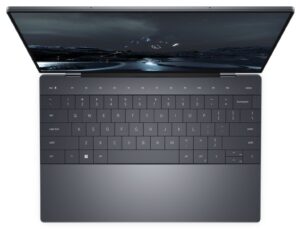[In-Depth Comparison] Lenovo ThinkPad Z13 Gen 1 vs Dell XPS 13 Plus 9320 – Two Heirs of storied brands
 The ThinkPad and XPS series are equally important to the laptop world. Both can trace their roots back to the 90s, which means that certain expectations are present. With the two laptops that we have today, Lenovo and Dell are trying to break away from the mold and create something that looks to the future, while respecting the past.
The ThinkPad and XPS series are equally important to the laptop world. Both can trace their roots back to the 90s, which means that certain expectations are present. With the two laptops that we have today, Lenovo and Dell are trying to break away from the mold and create something that looks to the future, while respecting the past.
The ThinkPad Z13 is a lot more luxurious than other members of the family, making some bold design choices. The XPS 13 Plus 9320 keeps parts of its design the same as other XPS devices, while radically shifting others. In terms of the hardware inside, both laptops follow the same philosophy of using ULV CPUs but rely on different manufacturers, with the ThinkPad using the Ryzen 6000U-series, while the XPS makes do with the Alder Lake P-series.
Today we present you with an in-depth comparison between the Lenovo ThinkPad Z13 Gen 1 and the Dell XPS 13 Plus 9320.
Lenovo ThinkPad Z13 Gen 1: Full Specs / In-depth Review
Dell XPS 13 Plus 9320: Full Specs / In-depth Review
Lenovo ThinkPad Z13 Gen 1 configurations:
Dell XPS 13 Plus 9320 configurations:
Contents
Design and construction
The Z13 brings a whole new identity to the ThinkPad brand, offering a stylized package that’s entirely made of aluminum. The device has a dark grey finish, with there also being an option for a Vegan leather cover, spicing up a laptop that’s already pretty spicy by itself. The sides are glossy, with some of the sharpest edges that we’ve seen. There is a slight protrusion on the top of the lid, which houses an FHD Webcam with an IR sensor for face recognition. It is very portable, weighing only 1.19 kg and having a profile of 14 mm.
The XPS 13 is the more minimal device of the two. When closed, it doesn’t even look like a laptop, reminding us more of a slab of metal with a Dell logo on top. The notebook has a silver finish, along with sharp edges and rounded corners. Durability is quite good with no flex from both the lid and the base. It is a bit heavier, with a weight of 1.27 kg, however, if you get the Z13 with a touch-enabled panel, it increases its weight to 1.26 kg, so it doesn’t really matter.
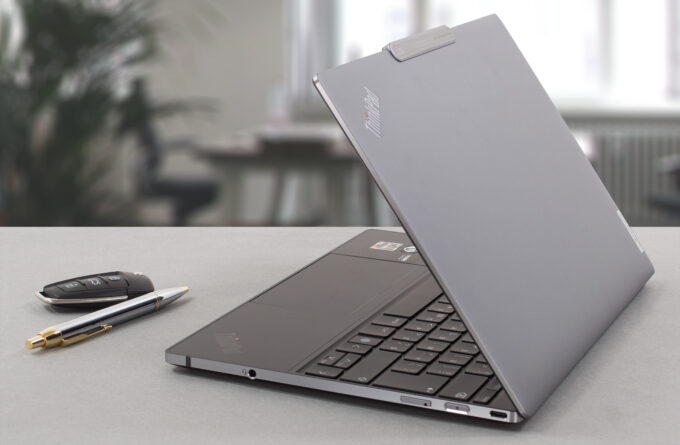 Lenovo ThinkPad Z13 Gen 1
Lenovo ThinkPad Z13 Gen 1 Dell XPS 13 Plus 9320
Dell XPS 13 Plus 9320Keyboard and touchpad
The ThinkPad doesn’t have a lot of space for its keyboard, sporting an edge-to-edge unit with spill resistance and a backlight. The key travel is a bit short, thanks to the slim profile, however, the keys are tactile, which is great for typing. There is a fingerprint reader inside a dedicated key. The touchpad is very different from other ThinkPads, offering a haptic motor that mimics a click. The top portion is also used to control the Red TrackPoint. The pad is covered in glass. Overall the pad is nice, but the area for the TrackPoint can use some more work, as currently, you feel weird clicks, which might get annoying for some.
The Dell device has a keyboard with virtually no space between the keycaps. It also spans from edge to edge. Typing on it is great, with the clicky feedback and large keycaps, while the backlight provides good illumination during the night. However, you might have some accidental presses here and there until you get used to it. Above and below the keyboard, we have two glass panels. The top one is used for some capacitive touch keys, which act as the F-row. The bottom one houses the touchpad, but the exact area isn’t highlighted. It uses the same haptic motor trickery to mimic a click, however, it feels very realistic, while tracking is very accurate.
 Lenovo ThinkPad Z13 Gen 1
Lenovo ThinkPad Z13 Gen 1 Dell XPS 13 Plus 9320
Dell XPS 13 Plus 9320Ports
The port selection is limited on both laptops.
The ThinkPad Z13 comes with two USB4 ports, which use the Type-C connector and offer a bandwidth of up to 40Gbps, a SIMcard tray, and a 3.5 mm audio jack.


On the XPS side, there are only two Thunderbolt 4 ports.


Disassembly, upgrade options
Both laptops come with soldered memory, with up to 32GB of LPDDR5 RAM. In terms of storage, the ThinkPad Z13 and the XPS 13 have one M.2 PCIe x4 slot which fit Gen 4 SSDs.
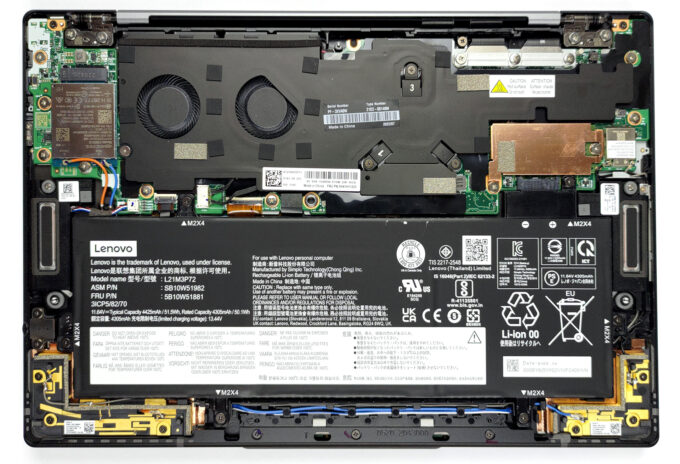 Lenovo ThinkPad Z13 Gen 1
Lenovo ThinkPad Z13 Gen 1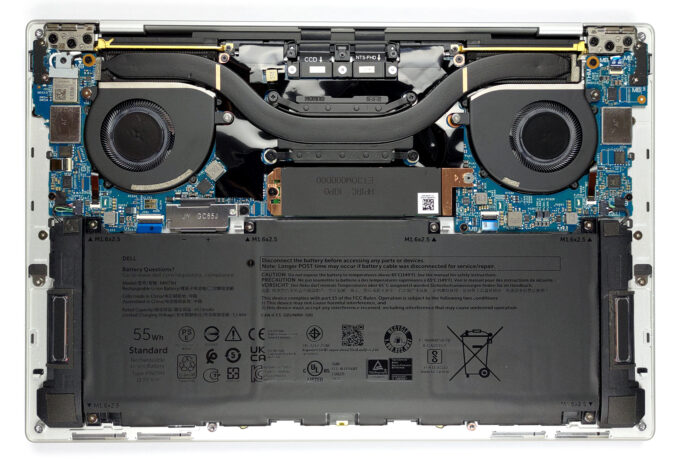 Dell XPS 13 Plus 9320
Dell XPS 13 Plus 9320Spec sheet comparison
Lenovo ThinkPad Z13 Gen 1 series
- Dimensions
- 294.4 x 199.6 x 13.99 mm (11.59" x 7.86" x 0.55")
- Weight
- 1.19 kg (2.6 lbs)
- Price
- Starting at $749.00
Dell XPS 13 Plus 9320 series
- Dimensions
- 295.3 x 199.04 x 15.28 mm (11.63" x 7.84" x 0.60")
- Weight
- 1.27 kg (2.8 lbs)
- Price
- Starting at $979.99
Display quality
The Z13 has two 13.3-inch displays with either an FHD+ IPS panel or a 2.8K OLED panel. Both of them have a 16:10 aspect ratio. We had the IPS option, which results in a pixel density of 170 PPI, a pitch of 0.15 x 0.15 mm, and a Retina distance of 51 cm.
The XPS 13 has 13.4-inch displays, with a FHD+ IPS panel, a 3.5K OLED panel, and a 4K UHD+ IPS panel. We tested the FHD+ screen, which is totally enough for this display size. Under a microscope, it’s frighteningly similar, with a pixel density of 169 PPI, the same pitch, and a Retina distance of 50 cm.
 Lenovo ThinkPad Z13 Gen 1
Lenovo ThinkPad Z13 Gen 1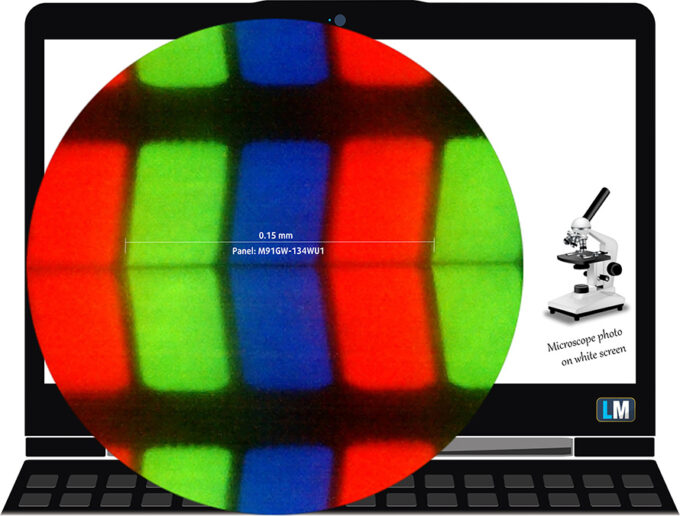 Dell XPS 13 Plus 9320
Dell XPS 13 Plus 9320With IPS panels, both laptops have excellent viewing angles. Here we have images at 45 degrees to evaluate quality.
 Lenovo ThinkPad Z13 Gen 1
Lenovo ThinkPad Z13 Gen 1 Dell XPS 13 Plus 9320
Dell XPS 13 Plus 9320The ThinkPad has a max brightness of 424 nits in the middle of the screen and 373 nits average across the surface with a maximum deviation of 19%. This makes the bottom left uneven in terms of brightness, which might give off inaccurate colors. The contrast ratio measures 1480:1.
On the XPS laptop, we have a higher peak brightness of 451 nits in the middle of the screen and 434 nits average across the surface with a lower maximum deviation of 14%. The contrast ratio is quite higher, at 2140:1.
 Lenovo ThinkPad Z13 Gen 1
Lenovo ThinkPad Z13 Gen 1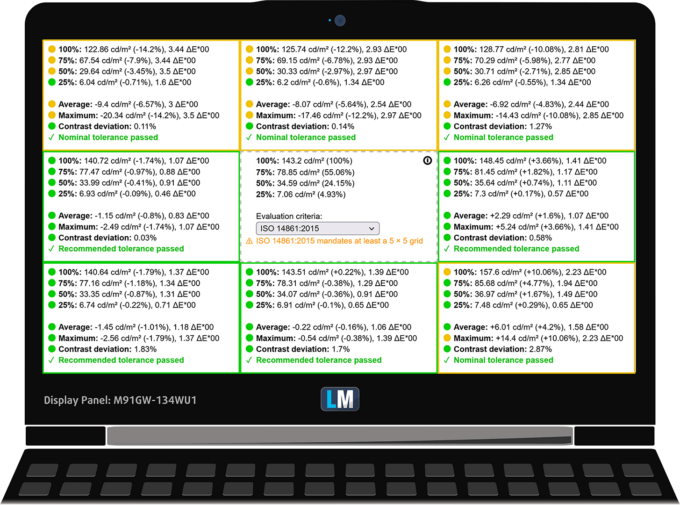 Dell XPS 13 Plus 9320
Dell XPS 13 Plus 9320Color coverage
To make sure we are on the same page, we would like to give you a little introduction to the sRGB color gamut and the Adobe RGB. To start, there’s the CIE 1976 Uniform Chromaticity Diagram that represents the visible specter of colors by the human eye, giving you a better perception of the color gamut coverage and the color accuracy.
Inside the black triangle, you will see the standard color gamut (sRGB) that is being used by millions of people on HDTV and on the web. As for the Adobe RGB, this is used in professional cameras, monitors, etc for printing. Basically, colors inside the black triangle are used by everyone and this is the essential part of the color quality and color accuracy of a mainstream notebook.
Still, we’ve included other color spaces like the famous DCI-P3 standard used by movie studios, as well as the digital UHD Rec.2020 standard. Rec.2020, however, is still a thing of the future and it’s difficult for today’s displays to cover that well. We’ve also included the so-called Michael Pointer gamut, or Pointer’s gamut, which represents the colors that naturally occur around us every day.
The yellow dotted line shows the color coverage of both the Lenovo ThinkPad Z13 Gen 1 and the Dell XPS 13 Plus 9320 which cover 95% and 88% of the sRGB gamut, respectively.
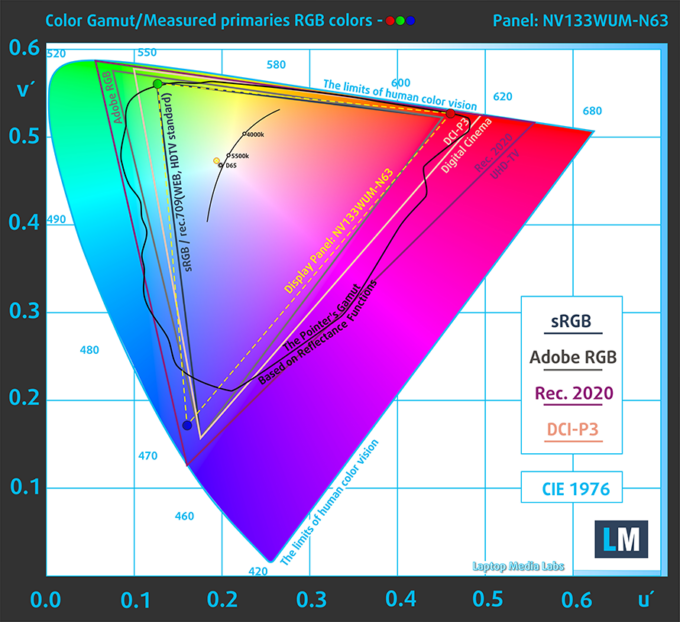 Lenovo ThinkPad Z13 Gen 1
Lenovo ThinkPad Z13 Gen 1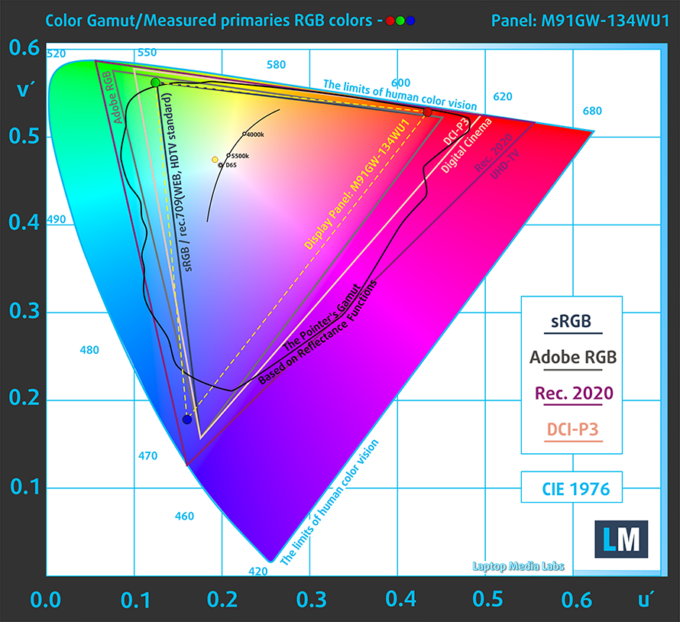 Dell XPS 13 Plus 9320
Dell XPS 13 Plus 9320Color accuracy
We tested the accuracy of the display with 24 commonly used colors like light and dark human skin, blue sky, green grass, orange, etc. You can check out the results in factory condition and also, with the “Design and Gaming” profile.
Below you can check the results from the test of both laptops, with both the factory settings (left) and with our “Design and Gaming” profile applied (right).
Both devices reach a low enough dE value using our Design and Gaming profile, to be considered ready for professional work.
Lenovo ThinkPad Z13 Gen 1
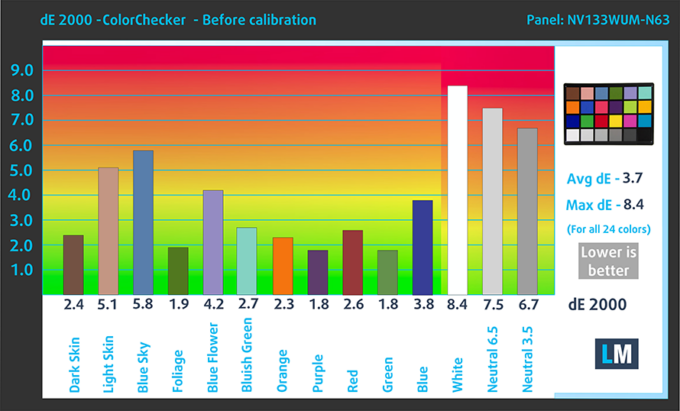

Dell XPS 13 Plus 9320
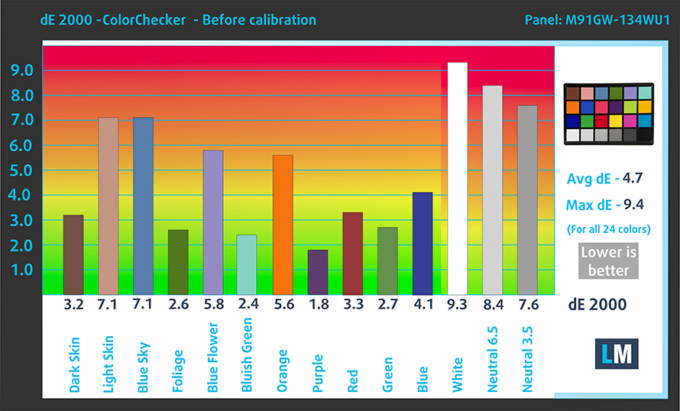

Response time (Gaming capabilities)
We test the reaction time of the pixels with the usual “black-to-white” and “white-to-black” method from 10% to 90% and vice versa.
Since these aren’t gaming laptops, they don’t have low response times. Still, the Dell is 2ms quicker with a Fall + Rise time of 23.3 ms.
 Lenovo ThinkPad Z13 Gen 1
Lenovo ThinkPad Z13 Gen 1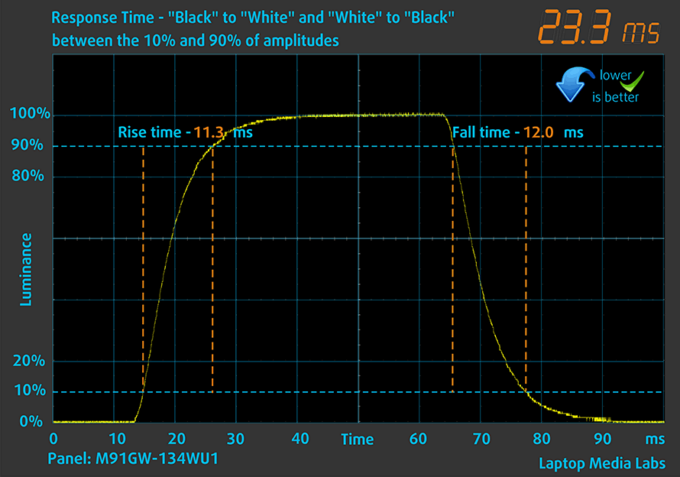 Dell XPS 13 Plus 9320
Dell XPS 13 Plus 9320Health Impact – PWM / Blue light
PWM – Screen flickering
Pulse-width modulation (PWM) is an easy way to control monitor brightness. When you lower the brightness, the light intensity of the backlight is not lowered, but instead turned off and on by the electronics with a frequency indistinguishable by the human eye. In these light impulses, the light/no-light time ratio varies, while brightness remains unchanged, which is harmful to your eyes. You can read more about that in our dedicated article on PWM.
Both laptops use no PWM across all brightness levels, meaning that the displays are comfortable to use, without presenting any excessive eye strain in this aspect.
 Lenovo ThinkPad Z13 Gen 1
Lenovo ThinkPad Z13 Gen 1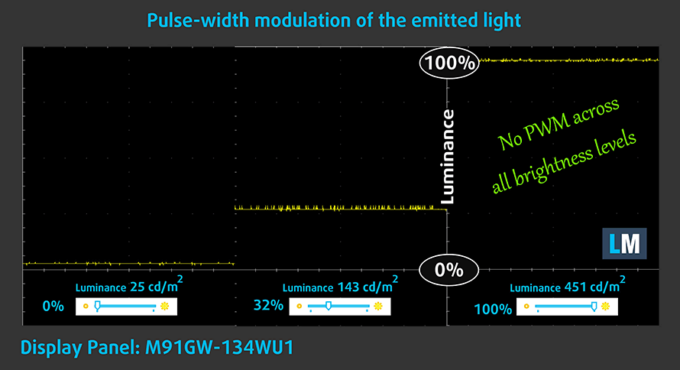 Dell XPS 13 Plus 9320
Dell XPS 13 Plus 9320Blue light emissions
Installing our Health-Guard profile not only eliminates PWM but also reduces the harmful Blue Light emissions while keeping the colors of the screen perceptually accurate. If you’re not familiar with the Blue light, the TL;DR version is – emissions that negatively affect your eyes, skin, and your whole body. You can find more information about that in our dedicated article on Blue Light.
Buy our profiles
Lenovo ThinkPad Z13 Gen 1 13.3″ BOE NV133WUM-N63 (LEN41A7) (Full HD+, 1920 x 1200) IPS: Buy our profiles
Dell XPS 13 Plus 9320 13.4″ M91GW-134WU1 (INT3480) (FHD+, 1920 × 1200) IPS: Buy our profiles
Battery life
It looks like AMD’s efficiency is on full display, as despite carrying the smaller battery pack, the ThinkPad Z13 manages to last for 2 hours and 27 minutes more in web browsing and 4 hours and 10 minutes more in video playback. The way we test our notebooks is with the Windows Better performance setting turned on, screen brightness adjusted to 120 nits, and all other programs turned off except for the one we are testing the notebook with.
In order to simulate real-life conditions, we used our own script for automatic web browsing through over 70 websites.
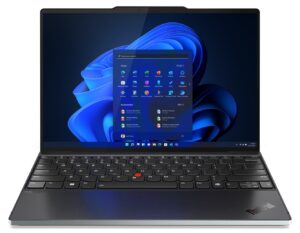
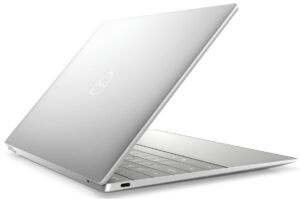
For every test like this, we use the same video in HD.


Performance
The ThinkPad Z13 carries the new Zen 3+ processors from AMD, with three Ryzen 6000U-series SKUs: the Ryzen 5 6500U, the Ryzen 7 6800U, and the Ryzen 7 Pro 6850U. For graphics, we are pleased to finally see the new RDNA 2 integrated graphics in person, which should totally outperform the competition.
The Dell laptop is powered by the Alder Lake P-series, with a total of four CPUs: the Core i5-1240P, the Core i7-1260P, Core i7-1270P, and the Core i7-1280P. In terms of graphics, we have the Iris Xe Graphics G7, which were top-notch last year, so let’s see how they match up against the new challenge from AMD.
CPU benchmarks
Here we tested the Ryzen 7 Pro 6850U and the Core i7-1260P. The Ryzen chip is a bit quicker in 3D Rendering, scoring 12% higher. On the other hand, Intel chips are notoriously fast in Photoshop, finishing the benchmark 1.4 seconds quicker.
Results are from the Cinebench R23 CPU test (the higher the score, the better)
Results are from our Photoshop benchmark test (the lower the score, the better)
GPU benchmarks
Here we tested the Radeon 680M and the Iris Xe Graphics G7 (96EU). The new iGPU is a fair bit faster, scoring 27% and 13% higher in 3DMark Fire Strike and Unigine Superposition, respectively.
Results are from the 3DMark: Time Spy (Graphics) benchmark (higher the score, the better)
Results are from the 3DMark: Fire Strike (Graphics) benchmark (higher the score, the better)
Results are from the 3DMark: Wild Life benchmark (higher the score, the better)
Results are from the Unigine Superposition benchmark (higher the score, the better)
Gaming tests
 Lenovo ThinkPad Z13 Gen 1
Lenovo ThinkPad Z13 Gen 1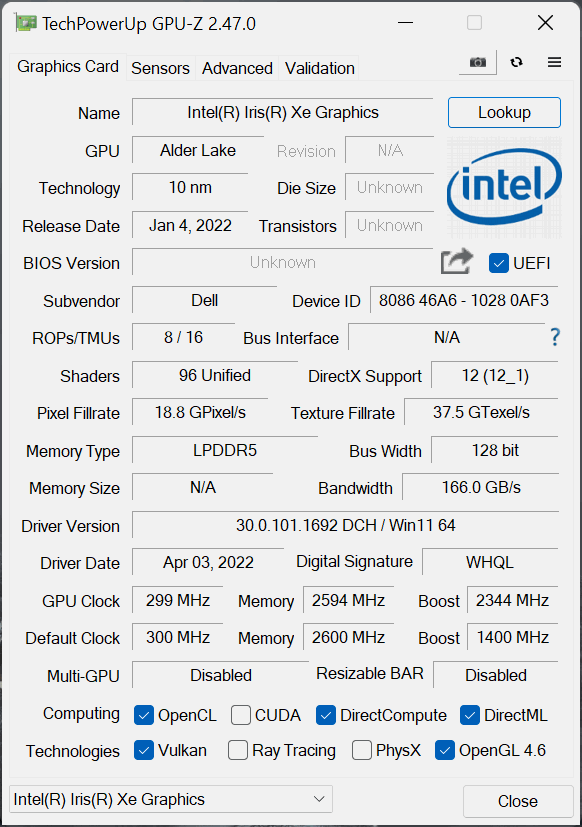 Dell XPS 13 Plus 9320
Dell XPS 13 Plus 9320
| CS:GO | HD 1080p, Low (Check settings) | HD 1080p, Medium (Check settings) | HD 1080p, MAX (Check settings) |
|---|---|---|---|
| Lenovo ThinkPad Z13 Gen 1 – Radeon 680M | 162 fps | 115 fps | 95 fps (+9%) |
| Dell XPS 13 Plus 9320 – Iris Xe Graphics G7 (96EU) | 175 fps (+8%) | 136 fps (+18%) | 87 fps |

| DOTA 2 | HD 1080p, Low (Check settings) | HD 1080p, Normal (Check settings) | HD 1080p, High (Check settings) |
|---|---|---|---|
| Lenovo ThinkPad Z13 Gen 1 – Radeon 680M | 143 fps | 103 fps | 78 fps (+22%) |
| Dell XPS 13 Plus 9320 – Iris Xe Graphics G7 (96EU) | 150 fps (+5%) | 104 fps (+1%) | 64 fps |
Temperatures and comfort
Beneath all the insulation plastic, we find the cooling setup of the Z13. It consists of one heat pipe with two fans and a long heat sink.
The XPS 13 also uses two fans and one pipe, however, offers two heat sinks instead of one. Also, the two fans have a much more standard positioning on the left and right sides, instead of being clumped up together, as is the case for the ThinkPad.
 Lenovo ThinkPad Z13 Gen 1
Lenovo ThinkPad Z13 Gen 1 Dell XPS 13 Plus 9320
Dell XPS 13 Plus 9320Max CPU load
| AMD Ryzen 7 PRO 6850U (15W TDP) | 0:02 – 0:10 sec | 0:15 – 0:30 sec | 10:00 – 15:00 min |
|---|---|---|---|
| Lenovo ThinkPad Z13 Gen 1 | 3.44 GHz @ 85°C @ 47W | 3.25 GHz @ 89°C @ 41W | 2.51 GHz @ 79°C @ 22W |
Since this is the first laptop with the Ryzen 7 Pro 6850U, we don’t have anything to compare the cooling against. Still, the CPU shows high lock speeds in the first 30 seconds, along with an increase in wattage. At the final stage, the clock speed drops below the base speed, which is something you don’t want to see.
| Intel Core i7-1260P (28W TDP) | 0:02 – 0:10 sec | 0:15 – 0:30 sec | 10:00 – 15:00 min |
|---|---|---|---|
| Dell XPS 13 Plus 9320 | 2.88 GHz @ 2.39 GHz @ 78°C @ 47W | 2.76 GHz @ 2.33 GHz @ 94°C @ 44W | 2.08 GHz @ 1.67 GHz @ 82°C @ 28W |
| Dell Vostro 16 5620 | 2.55 GHz @ 2.14 GHz @ 73°C @ 41W | 2.54 GHz @ 2.12 GHz @ 82°C @ 40W | 1.97 GHz @ 1.61 GHz @ 74°C @ 28W |
| Lenovo ThinkPad T16 Gen 1 | 2.66 GHz @ 2.29 GHz @ 72°C @ 47W | 1.21 GHz @ 1.53 GHz @ 63°C @ 20W | 1.26 GHz @ 1.54 GHz @ 64°C @ 20W |
Compared to the rest of the field that’s powered by the Core i7-1260P, the XPS 13 provides the highest clock speeds and highest wattage, at the expense of higher temperatures, maxing out at 94°C. Keep in mind that the other laptops are a lot larger with the possibility for better cooling, so the fact that the 9320 manages to do better than them speaks a lot to the cooling ingenuity of the Dell XPS engineering team.
Comfort during full load
Since both laptops have two fans, noise is definitely noticeable, but since the CPUs on the inside are more efficient, they don’t need to do a lot of work to be kept in check. In terms of temperatures, the XPS 13 has a cooler hotspot of 43°C, however, the temperature is spread evenly, so you will feel it over the entire base.
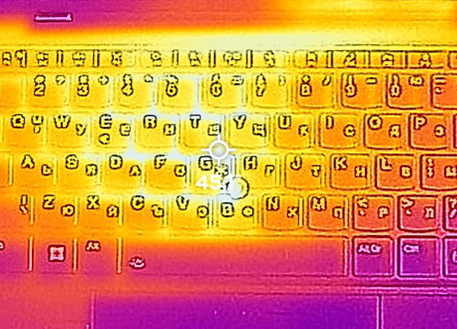 Lenovo ThinkPad Z13 Gen 1
Lenovo ThinkPad Z13 Gen 1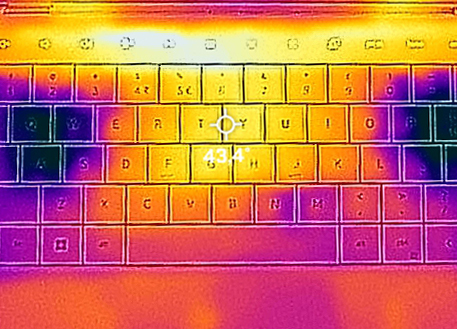 Dell XPS 13 Plus 9320
Dell XPS 13 Plus 9320Verdict
These two devices are created by experts in the laptop world, whose daily job is to push the boundaries of performance and portability. Recently, they have also been given the task to innovate as much as possible, resulting in the ThinkPad Z13 and the XPS 13 Plus 9320. Both laptops are beautifully crafted from metal, with the Dell model being much more minimal and futuristic.
The Z13 doesn’t try to hide its quirkiness, with a very visible protrusion that houses the webcam and face recognition sensors. It also relies on a more standard luxurious appearance, going as far as to offer a leather back cover. If we had to liken them to members of the automotive world, the Z13 is like an Audi RS7, which has sporty interiors and a mix of materials, while the XPS 13 looks like a Tesla Model S, being as minimal as possible, without the build quality issues which follow the biggest EV company in the world.
Both laptops have keyboards with short key travel and clicky feedback, resulting in comfortable typing. The touchpads also use the same way of mimicking clicks, with a haptic motor that needs some getting used to. The ThinkPad goes one further, replacing the TrackPoint physical buttons with the same tech.
I/O is scarce, but the Z13 offers more than the two Type-C ports on the XPS 13, with a SIMcard tray and an audio jack. They also share the same type of soldered LPDDR5 RAM and one M.2 slot for SSDs.
The XPS display does have lower color coverage, but is slightly more accurate and has higher brightness and contrast ratio. It’s also much more even across its entire area, so colors will appear the same throughout the whole panel. The Lenovo laptop offers longer battery life thanks to its Zen 3+ processors, which also perform better in 3D Rendering. Unfortunately for AMD, Intel is still king when it comes to short tasks, as the XPS is 1.4 seconds quicker in Photoshop.
However, the new RDNA 2 integrated graphics inside the AMD 6000-series do a lot better in benchmarks, while the performance advantages performance in games shows up at higher settings. Both laptops do as much as possible for the cooling, but the 13-inch form factor is limiting. With only one heat pipe and two fans, temps rise up, but the noise isn’t as high as we thought it would be.
Both laptops are fantastic pieces of technology, and we are glad to be able to have them in our lab for tests. Both excel in terms of build quality and design, while the performance difference comes down to AMD vs Intel. This means that if you had to make a choice between the ThinkPad Z13 and the XPS 13 Plus 9320, you should look into your workload and what you want to do with the laptop.
Why choose the Lenovo ThinkPad Z13 Gen 1?
- Higher color coverage
- Longer battery life
- Slightly more populated I/O
- Better 3D Rendering performance
Why choose the Dell XPS 13 Plus 9320?
- Higher contrast ratio
- More even brightness
- Faster 2D Rendering performance
Lenovo ThinkPad Z13 Gen 1: Full Specs / In-depth Review
Dell XPS 13 Plus 9320: Full Specs / In-depth Review
Lenovo ThinkPad Z13 Gen 1 configurations:
Dell XPS 13 Plus 9320 configurations:
